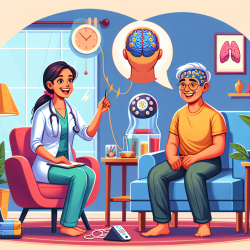Introduction
As a speech-language pathologist, staying abreast of the latest research and technological advancements is crucial for improving therapeutic outcomes. One such breakthrough is the use of home-based transcranial direct current stimulation (tDCS) in treating primary progressive aphasia (PPA). A recent pilot study titled Home-Based Transcranial Direct Current Stimulation in Primary Progressive Aphasia: A Pilot Study offers promising insights into this innovative approach.
Understanding the Study
The study explored the efficacy of home-based anodal tDCS delivered to the left supramarginal gyrus, coupled with verbal short-term memory/working memory (vSTM/WM) treatment, in improving language abilities in PPA patients. The results indicated significant improvements in verbal short-term memory and generalization to other language abilities such as spelling and learning.
Key Findings
- Significant Improvement in vSTM: Participants who received active tDCS showed notable enhancement in verbal short-term memory, particularly in backward word span tasks.
- Generalization of Language Skills: The study observed improvements in spelling and learning, suggesting that the benefits of tDCS extend beyond the targeted vSTM/WM tasks.
- Feasibility of Home-Based Application: The study demonstrated that home-based tDCS is not only feasible but also effective, providing a viable alternative to in-person therapy sessions.
Implications for Practice
For practitioners, these findings underscore the potential of integrating tDCS into therapeutic protocols for PPA. The ability to administer tDCS remotely can significantly reduce barriers to treatment, such as travel constraints and associated costs. Moreover, the generalization of language improvements suggests that this approach could enhance overall communication abilities in PPA patients.
Encouraging Further Research
While the pilot study offers promising results, further research is necessary to validate these findings across larger and more diverse populations. Practitioners are encouraged to engage in or support additional studies to explore the long-term effects and potential applications of tDCS in various speech and language disorders.
Conclusion
The integration of home-based tDCS in speech therapy for PPA represents a significant advancement in the field. By leveraging this technology, practitioners can offer more accessible and potentially more effective treatment options for their patients. To delve deeper into the research, you can access the full study here.










